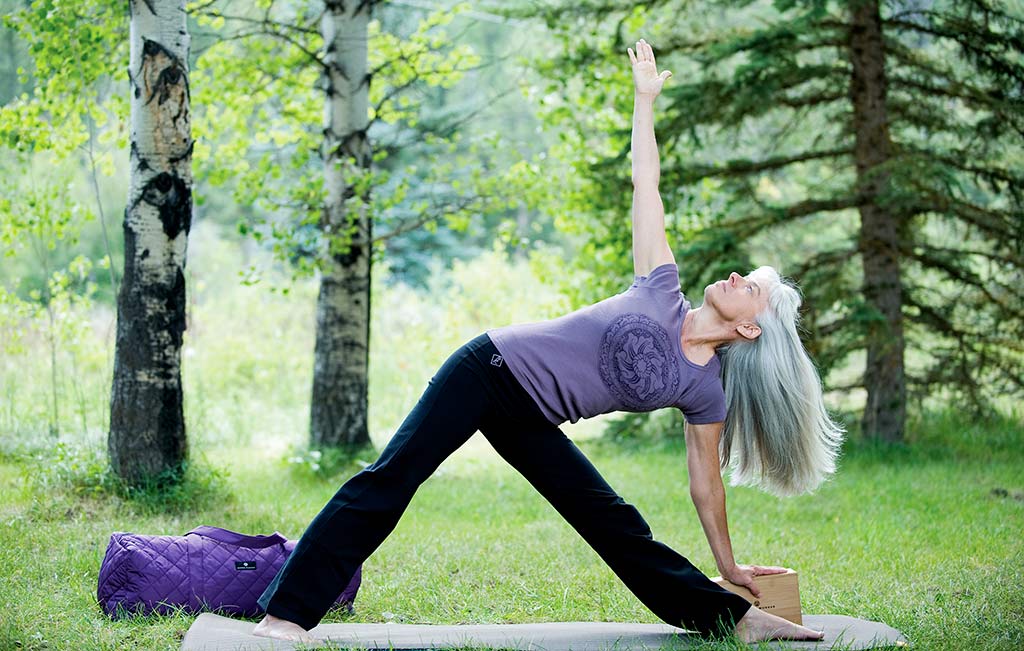
It’s that time of year again—resolution time. If you haven’t yet made a resolution—or resolutions—you’re not alone. According to an article in Forbes, only 40 percent of Americans make resolutions. Only 8 percent of Americans stick to them.
Still, it’s not a bad idea to set intentions for the new year. Because this blog concerns all things yoga, I’m going to delve into yoga resolutions. And because I’m over 50, I’m going to focus on how to approach starting classes when you’re in my demographic.
I began practicing in my 20s, but over the years my practice has evolved in ways I couldn’t have predicted. A healthy percentage of my students are in my age range. Many of them have practiced with me for decades. So we’ve all seen our bodies, our practices and our lives change.
Maybe you’re thinking of starting a yoga practice at 50-plus. Or maybe you’re thinking of resurrecting a practice you abandoned years ago. Perhaps you’re feeling your current practice is not working for you and would like to explore something else. The best way to make your practice stick is to make sure it’s sustainable. By “sustainable,” I mean that it’s important that your yoga practice replenishes and invigorates you, rather than choosing a practice that wears you out.
According to a new book, Yoga Healthy for Aging, by Nina Zolotow and Baxter Bell—an excellent book, by the way—there are four qualities that we should endeavor to develop in our asana practice. These qualities help us live a more graceful life even as our bodies change. These qualities are:
- Strength
- Flexibility
- Balance
- Agility
Most types of asana practice develop a measure of these qualities, but some are not sustainable, and that is key, especially for the over-50 crowd. Cultivating these qualities will require different foci for different individuals. Still, here are a few ideas for finding the right practice for you.
Over-50 Yoga Practice
Find a class. Unless you’ve enjoyed consistent practice for a long time, it’s easier to keep your practice going if commit to a class. This is not as easy as it sounds. Yoga studios may be ubiquitous, but types of yoga vary wildly. If your intention is to whip yourself into shape, you might be tempted to hit a Hot Yoga or Power Yoga class. I would strongly steer you to a Hatha Yoga class instead. Here’s why:
- In a Hot or Power class the pace is really fast. When you’re cycling through poses really quickly, teachers don’t have time to explain healthy alignment. It’s easy to develop unhealthy habits.
- These classes tend to feel more competitive. Most yoga injuries come from pushing too hard or stretching too far. If you hurt yourself going to a yoga class, you’re not likely to continue.
- Moving quickly from pose to pose can work well for people who are aware of pose names and healthy alignment practices. But if you walk into a vinyasa class with no familiarity with the asanas, you will likely feel pretty lost. It pays to find a slower-paced class where you can learn the poses and how to practice them with healthy alignment.
- Hatha Yoga classes are slower paced, with much more attention to alignment. Just because they move more slowly doesn’t mean that they’re less effective at developing strength, flexibility, balance and agility. In fact, they may be more effective. Yoga for Healthy Aging explains the physiological reasons why longer holds are more effective.
The faster-paced asana classes such as power and vinyasa are derived from Ashtanga Yoga. Ashtanga was taught to its best-known teacher, K. Patabhi Jois, when he was a preteen. It is actually intended to be a practice for the earlier stages of life. This doesn’t mean that the over-50 crowd can’t benefit from a faster-paced practice sometimes. It just means that it may not be sustainable for us over the long run, and it’s probably not the right place to start.
Here are a few more tips for over-50 practice:
- Start slow. Sometimes our intentions are way too much: “I’m going to go to yoga five times a week and practice an hour every day!” In this case, we’re likely to be disappointed if we can’t keep up with our aspirations. Commit to something you can easily fit into your life. And if you miss a day once in a while, remember that all is not lost. Step back onto your mat the next day.
- Ask questions. The proliferation of yoga teacher trainings has produced tons of teachers, but also a very wide variety of proficiency levels. It’s important, especially at first, to start with a teacher with many years of teaching experience. It takes years to develop an eye for structural variations. It also takes a long time to understand how to modify poses for people of varying structures. Find a teacher who’s not only been around a while, but someone who’s experienced in teaching over-50 yoga.
- If you practiced years ago, you may be surprised at the changes in your body’s strength, flexibility, balance or agility. These changes are absolutely normal. Aging is not a disease. It is written into our DNA. Meet your body where it is today.
- Yoga’s greatest gift is the quieting of the mind. Our minds can only rest in silence when we’re connected to each moment’s experience. When we’re wishing for our 20-year-old bodies, our minds will be in a state of struggle. Relax into your body just as it is right now. Be present to the sensations you feel and adjust your poses so that you can be at ease. That is where the yoga is.
Here’s a post that gives some more tips on finding the right class for you. It also gives brief descriptions of different styles of yoga.
